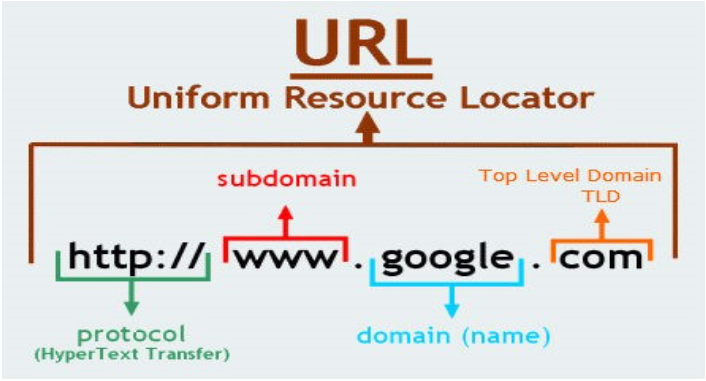
How to get domain name from URL in JavaScript
A javascript URL(Uniform Resource Locator) is another name for a web address. For instance, a word-based URL(Uniform Resource Locator) is i2tutorials.com. A URL(Uniform Resource Locator) can also be created using an IP address (ex. 192.168.2.25). Most users provide the name’s address when conducting an online search because names are easier to remember than numbers.
Web browsers use URLs to ask web servers for particular/given pages. Below is a list of a URL’s(Uniform Resource Locator) syntax and format.
Syntax
Scheme://prefix.domain:port/path/filename The different type of Internet services is define (http or https is being used in general).
Prefix-
It confirmed a domain prefix (www is the default for http).
Domain-
It consider the domain name on the internet (ex. javatpoint.com).
Port –
It recognize the port on the host (80 is the default for http).
Path –
It generates a path on the server side.
Filename –
It identifies a resource’s or document’s name.
Getting the domain name from a URL(Uniform Resource Locator) in javascript can be a useful task for different reasons, such as extracting the domain name for web analytics or security purposes. In this answer, we’ll explore various ways to extract the domain name from a URL(Uniform Resource Locator) in javascript, along with their pros and cons.
1. Using the window.location object
The most straightforward way to get the information domain name from a URL (Uniform Resource Locator) in javascript is to use the window.location object, which generates information about the current URL(Uniform Resource Locator). The window.location.host property gives us the domain name, including the port number if it’s present. Here’s an example:
Const domain = window.location.host; This approach has the advantage of being simple and reliable. However, it only works for the current URL(Uniform Resource Locator), so if you need to extract the domain name from a various URL(Uniform Resource Locator), you will need to use a different method.
2. Using the URL constructor
Another way to extract the domain name from a URL(Uniform Resource Locator) in javascript is to use the URL(Uniform Resource Locator) javascript constructor. It is a built-in javascript objects that can parse a URL(Uniform Resource Locator) string and provide access to its Different components. Here’s an example:
Consturl = new URL("https://www.example.com/path/to/file.html"); Const domain = url.hostname;
The URL(Uniform Resource Locator) constructor has the advantage of being able to extract the domain name from any valid URL(Uniform Resource Locator), not just the current one. However, it is only available in modern browsers, so you will need to check if it’s supported before using it.
3. Using regular expressions
A more advanced approach to extract the domain name from a URL(Uniform Resource Locator) in javascript is to use common expressions. Regular expressions are a powerful tool for pattern matching, and we can extract the domain name from a URL(Uniform Resource Locator). Here’s an example:
Consturl = "https://www.example.com/path/to/file.html"; Constdomain = url.match(/^(?:https?:\/\/)?(?:[^@\n]+@)?(?:www\.)?([^:\/\n]+)/im)[1];
This common expression pattern matches the domain name in a URL(Uniform Resource Locator), ignoring the protocol (http or https), email and password, and path. It works by looking for the first occurrence of a order of characters that does not include a colon, a slash, or a newline, preceded by an optional protocol, email and password, and optional “www.” prefix. The match method returns an array containing the entire match and any captured groups, so we need to extract the second item (at index 1) to get the domain name.
This approach has the advantage of being flexible and adaptable to various URL(Uniform Resource Locator) formats, but it is also more complex and prone to errors if the common expression pattern is not precise enough.
4. Using the DOM
Finally, we can also extract the domain name from a URL(Uniform Resource Locator) in javascript by using the DOM(Document Object Model). We can create a hidden anchor element, set its href attribute to the URL(Uniform Resource Locator) we want to extract the domain name from, and then read the hostname property. Here’s an example:
Consturl = "https://www.example.com/path/to/file.html"; Const a = document.createelement("a"); A.href = url; Const domain = a.hostname;
This approach has the advantage of being easy to understand and implement, but it also creates a DOM(Document Object Model) element, which may have some performance implications if you need to do this repeatedly.



